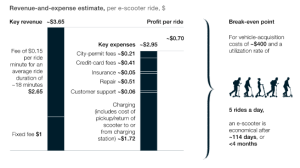Micromobility- bridging the connectivity gap
The implicit meaning of micromobility can be derived as “micro” referring to minimalistic means and “mobility” implying freedom of movement. Micromobility refers to a definite class of transportation in the form of electronic scooters and bikes which aid in shorter distance coverage across cities. Generally, they provide mobility solutions to or from other modes of transportation (bus, train, or car). This class of vehicles is light-weight, weighing a maximum of up to 500kgs. Micromobility is instrumental in transportation designed for a short journey, either propelled by human beings or powered by electric motors reaching a maximum speed range of 50 km/hour.
The thriving success of micromobility can be attributed to several factors. Micromobility extends hands by providing an economical solution to the first and last mile(s) problem. This transport mode (scooters, e-bikes, bicycles, and other personal transit) put forward towards its consumers a joyful alternative to public bus, pricey ride services, and unwanted walking, due to their affordable prices, and better on-demand availability.
The placement of the vehicles in notable positions are being constantly endeavored by the service providers to attract maximum customers. Previously, micromobility services were designed in such a way that vehicles need to be picked up and dropped at a particular location i.e, docks. However, recent advancement in micromobility services has been instrumental in adopting a dockless scenario where the users can leave behind the vehicles anywhere or within a geofenced region. The consumers generally rent such vehicles for a short period using an app. These apps are convenient, user-friendly apps that locate the nearest scooter, unlock it, provide identity and pay for the service. The e-scooter companies like Lime, Bird, Vogo, Skip, Spin, Jump permit the users to avail of the nearest micromobility services, impairing them from purchasing it.
The accessibility of micromobility has resulted in bringing down the number of personal automobiles and on the other end broadened economic opportunities for the global automakers to put money into various micromobility services. The reduction in traffic consequently leading to lowered emission levels has attracted the customers to a large scale. The services go a long way in solving the parking issues.
Keeping in view the profitability of the micromobility services, the durability of the vehicles was given special attention. The initial days saw the poor life cycle of the vehicles which soon was rectified by the manufacturers after speculating the customer needs. In the initial days, consumer e-scooters possessed a life of 2 to 3 months. The industry experienced a marked change in the life span to more than 10 months in recent years.
Thus the customer success of micromobility has been a contribution of these factors:
- Light-weight, Low-cost mobility
- First and last-mile solution
- User-friendly apps
- Hassle-free parking
- Less contribution to traffic
- Eco-friendly
- Availability of dockless mode of operation
- Enhanced vehicle durability
Why an e-scooter is more economical?
How big is the market?
The shared micromobility market in China, Europe and the United States is expected to reach $300 billion to $500 billion by 2030.
Source: mcKinsey.com
e-scooter Valuations and Investors ($ in millions of USD)
Source: Public announcements, Crunchbase, Tracxn, Base10 research


 中文
中文


